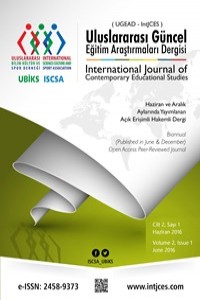Abstract
Teaching has been debated throughout the history. For this purpose several techniques have been developed and used. The use of methods in language teaching has been more effective in students achievement. Therefore the each new method was developed to close the missing of other method. In this context, language teaching through short stories is done. The use of short stories in language teaching makes it alive and effective. Because teaching language through short stories will contribute to development of reading, writing, speaking and listening skills. In this study, the place of short stories in teaching Arabic as a foreign language and how the short stories will contribute to students language skills will be discussed
Keywords
References
- Collie J., S. Slater (1987). Literature in the language classroom: A resource book of ideas and activities. Cambridge: CUP.
- Elliot R. (1990). Encouraging reader-response to literature in ESL situations in ELT Journal. (3):191-198.
- Eren Z. (2009). The use of short-story in teaching English to the students of public high schools. Hacettepe Üniversitesi Eğitim Fakültesi Dergisi, 26: 41-47.
- Erkaya O. R. (2005). Benefits of using short stories in the EFL context. The Asian EFL Journal, 11: 1-6
- Erten, İ. H., & Razı, S. (2007). Yerelleştirme ve okuduğunu Anlama. Yabancı dil eğitimi bölümlerinde edebiyat öğretimi, 162-176. Ankara: Anı.
- Ghasemi P., Hajizadeh R. (2011). Teaching L2 reading comprehension through short story.
- International Conference on Languages, Literature And Linguistics IPEDR. 26: 69-73. Khatib M., Seyyedrezai S. H. (2013) Short story based language teaching: A literature-based language teaching method. 2(2): 155-159.
- Krishna T. M., Sandhya K. (2015). The impact of short stories on teaching of English. Journal
- Of English Language And Literature 2(4): 58-62. Lazar G. (1993). Literature and language teaching: A guide for teachers and trainers. Cambridge: CUP.
- Memiş M. R., Erdem M. D. (2013). Yabancı dil öğretiminde kullanılan yöntemler, kullanım özellikleri ve eleştiriler. Turkish studies - International Periodical For The Languages,
- Literature And History Of Turkish Or Turkic. 8(9): 297-318. Özcan M. (2011). Yabancı dil öğretiminde öykü kullanımı. e-Journal of New World Sciences Academy. 6(3): 2133 – 2147
- Pourkalhor O., Kohan N. (2013). Teaching reading comprehension through short stories in advance classes. Asian Journal Of Social Sciences and Humanities. 2(2): 52-60.
- Prasad A B. R. (2015). Teaching English language through literature. International Journal Of
- English Language, Literature And Humanities. 3(7): 57-62
- Reading Arabic hard for brain, 05.05.2016 tarihinde http://www.bbc.com/news/health- adresinden erişildi.
- Silva B. R. (2001). Using literary texts in ESL classroom. Revista De Ciencias Humanas. (2): 171 – 178.
- Why is learning Arabic so hard, 05.06.2016 tarihinde http://outinafricaride.org/why-is- learning-arabic-so-hard/ adresinden erişildi.
Abstract
Yabancı dil öğretiminin nasıl yapılacağı tarih boyunca tartışma konusu olmuştur. Bu amaçla birçok yöntem ve teknik geliştirilmiş ve kullanılmıştır. Dil öğretiminde yöntemlerin kullanılması öğrencinin başarıya ulaşmasında daha etkili olmuştur. Bu nedenle geliştirilen her bir yeni yöntem diğer yöntemin eksiğini kapatmak amacıyla geliştirilmiştir. Bu bağlamda kısa hikâyeyle dil öğretimi de yapılmaktadır. Yabancı dil öğretiminde kısa öykünün kullanılması dili canlı ve etkin hale getirmektedir. Çünkü kısa hikâye aracılığıyla dil öğretimi dört dil becerisin olan dinleme okuma konuşma ve yazma becerilerinin gelişmesine katkı sağlayacaktır. Bu çalışmada ise yabancı dil olarak Arapça öğretiminde kısa hikâyenin yeri ele alınacak ve kısa hikâyelerin öğrencilerin dil becerilerini geliştirmelerine nasıl katkı sağlayacağına yer verilecektir
Keywords
References
- Collie J., S. Slater (1987). Literature in the language classroom: A resource book of ideas and activities. Cambridge: CUP.
- Elliot R. (1990). Encouraging reader-response to literature in ESL situations in ELT Journal. (3):191-198.
- Eren Z. (2009). The use of short-story in teaching English to the students of public high schools. Hacettepe Üniversitesi Eğitim Fakültesi Dergisi, 26: 41-47.
- Erkaya O. R. (2005). Benefits of using short stories in the EFL context. The Asian EFL Journal, 11: 1-6
- Erten, İ. H., & Razı, S. (2007). Yerelleştirme ve okuduğunu Anlama. Yabancı dil eğitimi bölümlerinde edebiyat öğretimi, 162-176. Ankara: Anı.
- Ghasemi P., Hajizadeh R. (2011). Teaching L2 reading comprehension through short story.
- International Conference on Languages, Literature And Linguistics IPEDR. 26: 69-73. Khatib M., Seyyedrezai S. H. (2013) Short story based language teaching: A literature-based language teaching method. 2(2): 155-159.
- Krishna T. M., Sandhya K. (2015). The impact of short stories on teaching of English. Journal
- Of English Language And Literature 2(4): 58-62. Lazar G. (1993). Literature and language teaching: A guide for teachers and trainers. Cambridge: CUP.
- Memiş M. R., Erdem M. D. (2013). Yabancı dil öğretiminde kullanılan yöntemler, kullanım özellikleri ve eleştiriler. Turkish studies - International Periodical For The Languages,
- Literature And History Of Turkish Or Turkic. 8(9): 297-318. Özcan M. (2011). Yabancı dil öğretiminde öykü kullanımı. e-Journal of New World Sciences Academy. 6(3): 2133 – 2147
- Pourkalhor O., Kohan N. (2013). Teaching reading comprehension through short stories in advance classes. Asian Journal Of Social Sciences and Humanities. 2(2): 52-60.
- Prasad A B. R. (2015). Teaching English language through literature. International Journal Of
- English Language, Literature And Humanities. 3(7): 57-62
- Reading Arabic hard for brain, 05.05.2016 tarihinde http://www.bbc.com/news/health- adresinden erişildi.
- Silva B. R. (2001). Using literary texts in ESL classroom. Revista De Ciencias Humanas. (2): 171 – 178.
- Why is learning Arabic so hard, 05.06.2016 tarihinde http://outinafricaride.org/why-is- learning-arabic-so-hard/ adresinden erişildi.
Details
| Other ID | JA32CS82EB |
|---|---|
| Journal Section | Review |
| Authors | |
| Publication Date | June 1, 2016 |
| Published in Issue | Year 2016 Volume: 2 Issue: 1 |

